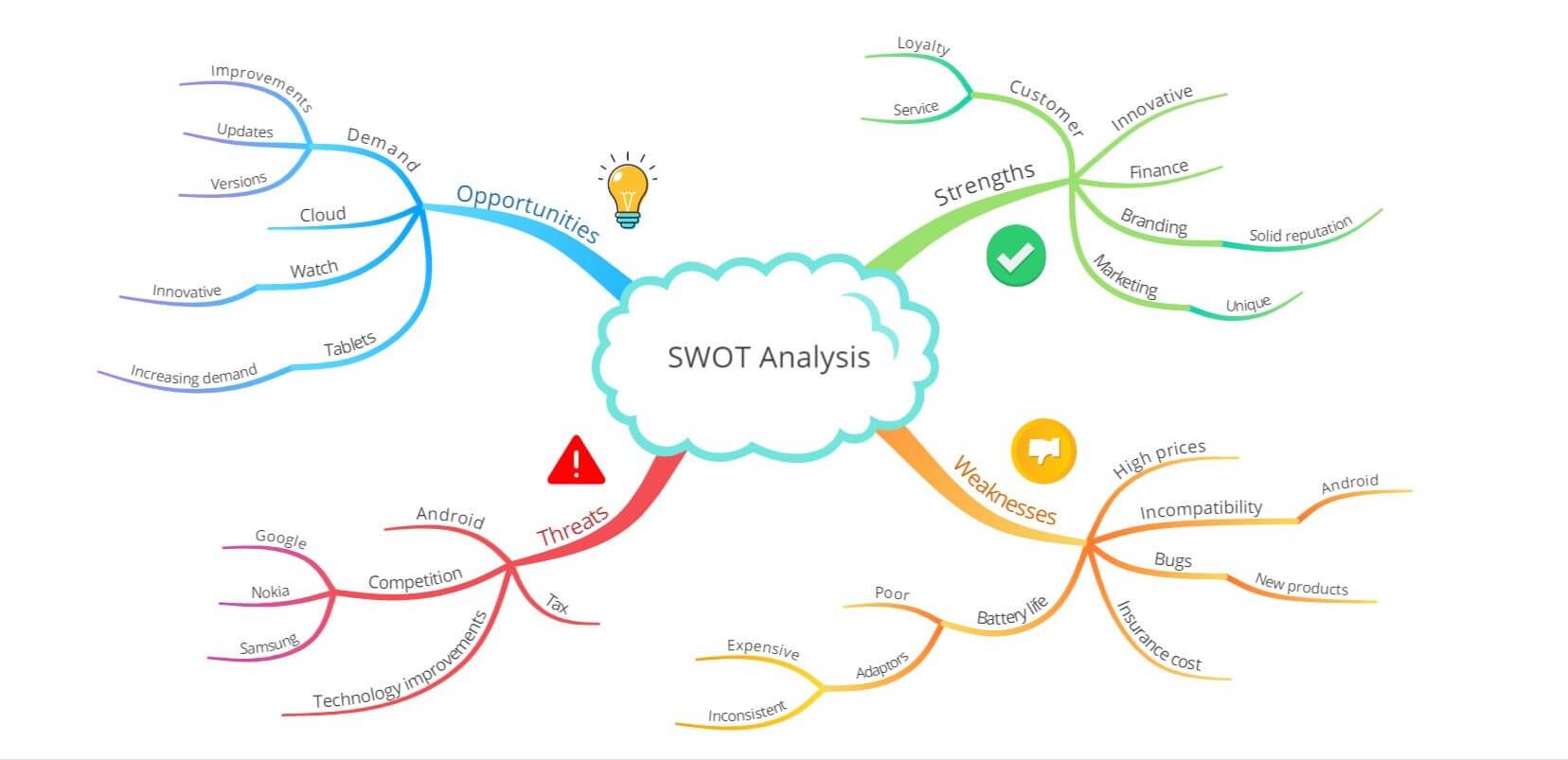March 23, 2020
What is SWOT analysis and are you doing it right?

If you work in an office environment, SWOT analysis is something that you will no doubt have heard of – even if you haven’t necessarily used it yourself. Standing for ‘Strengths’, ‘Weaknesses’, ‘Opportunities’ and ‘Threats’, SWOT is an extremely useful planning and problem-solving technique. In this blog, we’ll delve into what SWOT is, how you can use it, and how to ensure your SWOT analysis is as effective as it can be.
What is SWOT Analysis?
SWOT is a powerful, yet simple framework that can help individuals and organizations to be more strategic in their planning, leading to them producing better results – and it is one that has truly stood the test of time. Although it was invented by business and management consultant, Albert Humphrey, back in the 1960s, it remains an effective and popular tool to this very day.
Because it requires participants to weigh up the pros and cons of a specific area of a business, or simply what it will take to achieve a certain objective, a SWOT analysis can be applied to various processes.
This can range from a sales and marketing team conducting competitor research to an accounts department assessing their company’s financial resources. This effective planning tool can also help you to determine how your business should respond to new industry trends and implement new technologies.
The reason that SWOT is such an effective tool is because it encourages participants to look at an entire organization or specific project you’re working on from all areas; to consider the good and the not-so-good. As this process includes examining both the strengths and weaknesses, it will help you to reduce the likelihood of failure by identifying any potential threats and preparing for them before they have a chance to rear their ugly heads.
When conducting a SWOT analysis, you will need to take the following into consideration:
Internal factors
These are (or can be) controlled by you or your organization.
Strengths
What do you do well? What great resources do you have access to? What do your customers and competition see as your strengths?
Examples could include having a loyal customer base, having a strong team of employees, or having been recently awarded funding.
Weaknesses
What can you improve on? What resources are you lacking to help you achieve your goal(s)? What do your customers and competition see as your weaknesses?
Examples could include having a large amount of debt or a lack of employees that are skilled in a certain area (such as software development).
External factors
These can be impacted by anything out of your organization’s control – such as the economy, your market, your customer base or your competition.
Opportunities
What opportunities do your strengths present to you? What other opportunities are available to you due to current trends in your industry and other circumstances?
Examples could include someone in the business having the knowledge you need to produce a successful marketing campaign or a current industry trend making your product highly desirable.
Threats
What threats do your weaknesses present to you? What trends and circumstances could harm your project’s success or your organization as a whole?
Examples could include a shortage or rising of costs for manufacturing materials, or changes in trends that reduce the need for your product.
Tips for conducting an effective SWOT analysis
Choose the right format
Conventionally, a SWOT matrix is mapped out into a two-by-two grid, with the internal factors (strengths and weaknesses) running along the top, and the external factors (opportunities and threats) sitting underneath these. Many people do this by drawing the grid by hand or using software, such as a spreadsheet or word processing tool. However, using the technique of Mind Mapping can be an easy and effective way of taking your SWOT analysis to the next level, as it will encourage you to think of ideas and perspectives that wouldn’t immediately come to mind.
Every Mind Map starts with a central concept or idea, with additional ideas radiating outwards from this, mirroring our brain’s natural thinking processes. This encourages you to make associations between ideas, resulting in more being put down on the page (or on the map, in this case!). The fact that Mind Maps are highly visual, typically incorporating different branch styles, colors and images, can also help to boost your brain’s creative thinking power.

Making your SWOT analysis Mind Map digital (using dedicated software like Ayoa) can also be beneficial as your work is automatically saved online, meaning you can access it from anywhere, and easily make edits when needed. In Ayoa, there is already a Mind Map template available for you to get started. To access it, select ‘browse’ in the Mind Mapping section of Ayoa, then click on ‘+ New Mind Map’. From here, choose to use a template and select the SWOT Analysis template from the list of options that appear.
Consider a range of perspectives
A SWOT analysis should be a collaborative process; you need to consider your company’s (or your project’s) strengths, weaknesses, opportunities and threats from as many different angles as possible. This will help to ensure that nothing vital is missed.
It might sound clicheé, but two heads are always better than one – and the way to ensure that you cover all bases in your SWOT analysis is by getting people from various areas of your company involved in this process. If this task is given solely to a business’s marketing department, it’s likely that individuals within this team will share similar ideas or look at things from the same perspective. This is because they frequently work together on the same projects and consume and share the same information. So, to add some variety, make sure you extend an invite to a few members of your production, sales, finance and customer service teams too!
When it comes to encouraging collaboration, another advantage of turning your SWOT analysis into a digital Mind Map is that it makes it simple for everyone to add their thoughts. With Ayoa’s Public Mind Map Sharing option, sharing your SWOT analysis with multiple people is as easy as sending them the link to your Mind Map. If they want to vote on ideas or even add their own, all they need to do is sign up.
This also means that whether you’re meeting in person or from different locations, everyone can see the most up-to-date information as it’s edited in real-time – so everyone is always kept on the same page.
Focus your thinking
Although collaboration is a key part of conducting an effective SWOT analysis, it’s also vital to avoid falling into the trap of “groupthink”. This is a psychological phenomenon that occurs when people hold back from sharing their ideas and simply agree with others to try to keep the peace or avoid embarrassment caused by throwing a potential ‘left-field’ idea out there.
To overcome this hurdle, ask participants of the meeting to brainstorm on their own first, asking them to come up with as many ideas as possible – no matter how insignificant they might think they are. You can even save time by asking them to add these to a SWOT analysis Mind Map in Ayoa, ready to be discussed when you’re ready to meet as a team!
Now that you have your ideas down on the page, it’s time to choose which ones are the most important to you, or will make the most impact to your business or project you’re working on. For best practice, it is advised that each section of your SWOT analysis has between 3 and 5 ideas listed – any more than that, and you may become unfocused.
At this idea generation stage, scoring each factor contributed by your team (or using the voting function in Ayoa’s Mind Maps) can help you to narrow these down, giving you a clearer indication of which strengths, weaknesses, opportunities and threats are the most vital to focus on for success.
Set benchmarks against competitors
Unsure of where to start when it comes to analysing your business? Don’t underestimate the value of benchmarking. Looking at your most successful competitors and assessing how your business compares can be incredibly helpful when determining your strengths and weaknesses, as well as your potential opportunities and threats. As an example, the reason your pricing may be a strength could be due to the fact that it’s cheaper than your competitors’. In terms of your product quality, yours may be adequate, but your competitor’s may be better – making this a weakness and a threat, rather than a strength. Of course, this does also present the opportunity for you to improve your product quality, or lower your price further.
When setting benchmarks against competitors in your industry, some questions to ask yourself include: What are they doing to achieve these goals? Can you do the same? What can you do better? Is there something they’ve missed? These can all be great jumping off points if you’re in need of inspiration.
However, when determining your factors, don’t forget to ensure these are action-based, as this will give you a better understanding of what you will need to implement when the time is right. As an example, an action-based opportunity could be to create a software product that the market is currently lacking – particularly if you have the financial resources, skills and manpower to make this a reality.
Ready to put these tips into practice? Sign up to Ayoa for free and use our SWOT analysis template to get started. Share your Mind Map with others to gain vital perspectives from various areas of your business, then turn these ideas into actionable tasks directly in Ayoa. Find out more about Ayoa’s features and get started today!

